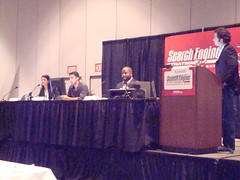
 Day one of SES continues with the hot topic of turning the social web into real ROI. Everyone knows the social web is essential to how we live our lives and stay connected, but many marketers aren’t finding returns on their ad spends.
Day one of SES continues with the hot topic of turning the social web into real ROI. Everyone knows the social web is essential to how we live our lives and stay connected, but many marketers aren’t finding returns on their ad spends.
Tim Kendall, Director of Monetization for Facebook moderates this heated session with speakers (R to L in the image):
- Sean Heywood, Managing Partner, MR Barber Shop & Urban Lounge
- Rogelio (Ro) Choy, Chief Revenue Officer, RockYou
- Claudia Virgilio, Vice President Western Region, Performics
Focusing on best practices in how marketers can leverage the social web as a simple way to quickly build and manage effective campaigns, this discussion had valuable takeaways for marketers interested in social media advertising.
The following is a summary of the questions and responses from this session:
Moderator: How does social media factor in to those who are very ROI driven?
Sean: We have found that when we isolate people within a demographic we are able to effectively target them. AdWords and PPC are great channels to pull out relevant traffic. A member to our network is worth around $780 over the course of their lifetime, so it’s worth our time to uncover those conversions. We actually started with search which lead to articles/press including in the NYT and the Daily Candy and then we spread into social.
Ro: There is actual engagement in social media ads, and we see campaigns with rates of .25% CTR – so effective social media engagement level is equal to any other web site. Also, every time you use social media it has the potential for “viral awareness” or social awareness which drives significant buzz around your program that leads to measurable impact.
Moderator: How are you thinking about the measurement/metrics surrounding social media/social spends? What do you emphasize?
Claudia: The metrics we look at are quantitative: conversions through actions/registration or a sale. We are also looking at engagement-based metrics as well such as time on site. We also look at things like number of fans, interactions, etc. or the idea of “social actions.”
Sean: Impressions matter but leads are more vital: how many are actually registering or signing up for membership?
Ro: Metrics include click-throughs/impressions and back-end conversions. No difference from traditional web metrics aside from engagement.
Moderator: How do you know if you are having a viral effect on social networks? How do you measure how “viral” a campaign is in concrete terms?
Ro: Actions such as “forwards” and “shares” – we try to identify what percentage are sharing. It’s difficult to see the inherent value, but the beauty of the fan is it captures the essence of what interest is. When people are forwarding things to a fan page, we have a measurable point of what “viral” can get you. Each fan can create a multiplier in awareness.
Moderator: Should marketers or businesses funnel traffic to their Facebook page or their web site? Where do you invest, what is most effective for customer acquisition?
Sean: I’m not sure the benefit of growing fans virally if I can’t equate it with customers at the end of the month. There are limitations with how to interact unfortunately. We have a fan page and are exploring different interactions to attempt conversions. For some reason I feel “jipped” when someone visits my Facebook fan page vs. my Web site which I spent so much resources developing.
Claudia: Social needs different types of metrics, we are in the process of identifying the value of getting people to different pages and between the social pages/corporate pages. We are looking to invest in impressions to sites and sales.
Ro: I definitely like the idea of fan pages more than Web sites. The fan page allows for the ability of a multiplier effect. By not doing this you are cutting off much of the opportunity that is there for you.
Moderator: What are the ways in which you walk clients/customers through the challenge of things such as low CTR?
Ro: We almost always couple a campaign with an integrated experience. “Pieces of Flair” is one of our apps created by Dawn. They are giving a dollar to the Wildlife Conversation fund every time someone engages in a social engagement through our app. You clean birds through applying Dawn in a game application, and then send the clean bird to a friend. The CTRs on that page were high because the campaign was social and contextual.
Moderator: Can you talk a little on micro-targeting best practices?
Claudia: What’s so great about micro-targeted is the idea of consumer profile development: we get really refined and specific as to who that person is that we are targeting. With search you’re targeting keywords, with social you are targeing personalities.
Sean: Our market is literally a 7×7 mile radius around San Francisco, so we are definitely micro-targeting. We have had reasonable success , but the impressions get so small as we try to go too deep. What we are trying to work on now is targeting first timers vs. members. If we know someone is already a member, it becomes a much easier sale.
Audience: Can you give us a % rate that you would quantify viral?
Ro: Anytime we see something like 30% forward rate, we get excited.
Claudia: I agree, a 30% forward rate is exciting.
Audience: should we give up our homepage for a Facebook page?
Sean: No, because you lose that immersive experience if you are selling physical products. We can’t necessarily recreate that great in-store experience on a Facebook page.
Moderator: A standalone website with Facebook connect lets you get much of the viral and distribution benefits of a Facebook page within your web site directly. They can work together, unfortunately you can’t yet do everything you can do in your own web environment.
Audience: How can you create messages that are effective at spreading vs that which is preachy:
Ro: Personalization is key, it should be to the specific user and bring attention to you.
Learn more search and social media marketing strategies from 2009 SES SJ coverage by TopRank Online Marketing


